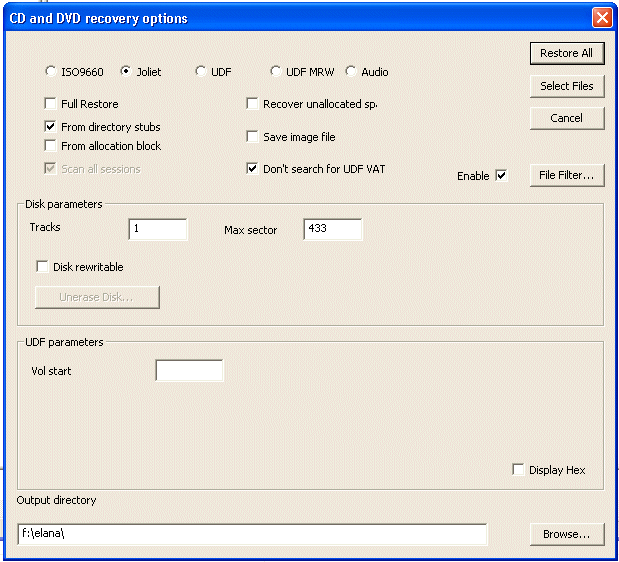|
CD Recovery
|   |
A CD may be restored in several ways, depending on if it is working correctly, or has failed in one way or another.
The program will try and determine the type of disk being read, but this can be over written by selecting 9660, Joliet, UDF, UDF with Mount Rainier, or Audio disks

There are two basic modes of restoration, Full Restore and From directory stubs
Full Restore
In Full Restore mode the program reads the disk in the a same way as an application would, but is very tolerant of errors. Files will be restored, and save in original subdirectories. For a multi-session disk, each session is saved in a separate base directory, Track1, Track2 etc. This has a feature where if a disk has been appended to, say 10 times, a file in Track1 may appear in every other track
From directory stubs
This is more of a recovery mode. The disk is scanned for sectors that are directories. Depending on the disk, the scanning can take a period of time, but the progress bar will indicate the amount of the disk scanned. The information is then decoded, and files recovered. Where ever possible, the parents of subdirectories are determined. Where no parent can be found, the found, the files are placed in a dirstub0, dirstub1 directory.
Scan all sessions
This is an option for UDF disks that have been written with packets, rather than separate sessions, or tracks. (It is also part of the forensic options, so not available on all versions of the software). It will show each session as a separate track. This way, each session could be restored separately, but more importantly, for a forensic investigation, one can see when files are added, or deleted. A normal restoration of the disk, will only restore the final session. One warning is that this examination process is rather slow, as the disk directory is constructed many times. This can also be a useful option when the final part of the disk is missing or corrupted. All sessions, up to the final one can then be recovered.
Disk Parameters
This section shows the number of tracks detected on the disk, along with the maximum sector number. As each sector is 2K in length, this will give the maximum number of bytes that can be restored. It should be noted though, that on multi session disks, a lot of data space is used as overhead between sessions, so the capacity of a disk with many tracks, if recorded in different sessions, will be much lower than the Max sector x 2K
Unerase disk
When the program detects a blank CD-RW disk, the unerase option is enabled. If a disk has been Quick Erased, there is a procdure where data may be recovered - see Unerase CD-RW for more details. This is Forensics only option, and so may not be enabled on all versions of the software licence.